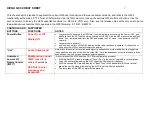
5
Apply marine sealant to the included 12 mm M4 screws, and
attach the cable-entry cover to the transom.
6
Wipe away all excess marine sealant.
Testing the Installation
NOTICE
You should check your boat for leaks before you leave it in the
water for an extended period of time.
Because water is necessary to carry the sonar signal, the
transducer must be in the water to work properly. You cannot
get a depth or distance reading when out of the water. When
you place your boat in the water, check for leaks around any
screw holes that were added below the water line.
Testing the Transom-Mount Transducer Installation
NOTICE
When adjusting the depth of the transducer, make the
adjustments in small increments. Placing the transducer too
deep can adversely affect the performance of the boat and put
the transducer at risk of striking underwater objects.
Test the transom-mount transducer installation in open water
free of obstacles. Pay attention to your surroundings as you test
the transducer.
1
With the boat in the water, turn on the chartplotter.
2
Drive the boat at a slow speed. If the chartplotter appears to
be working properly, gradually increase speed while
observing the chartplotter.
3
If the sonar signal is suddenly lost or the bottom return is
severely degraded, note the speed at which this occurs.
4
Return the boat to the speed at which the signal was lost,
and make moderate turns in both directions while observing
the chartplotter.
5
If the signal strength improves while turning, adjust the
transducer so that it extends another
1
/
8
in. (3 mm) below the
transom of the boat.
6
Repeat steps 2–4 until the degradation is eliminated.
7
If the signal does not improve, move the transducer to a
different location on the transom, and repeat the test.
3






















